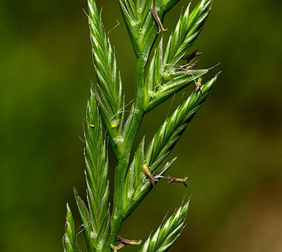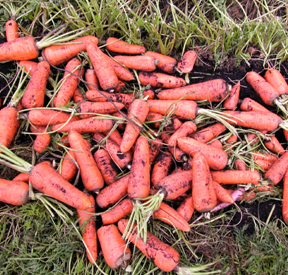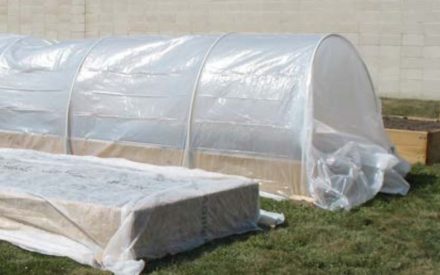Authors: Doug Higgins and Kristin Krokowski, UW-Extension Waukesha County, and Erin Silva, UW-Agronomy
Revised: 5/13/2012
Item number: XHT1209

What are cover crops?
Cover crops are plants grown in a garden to improve a soil’s physical structure and fertility. As cover crops grow, they become reservoirs for important plant nutrients such as nitrogen, phosphorus and potassium, as well as micronutrients. Cover crops also help prevent soil erosion, reduce weed problems, and provide a habitat for beneficial insects. Working cover crops into a garden returns nutrients to the soil making these nutrients available to future vegetable crops. Working cover crops into a garden also increases soil organic matter, improving the soil’s overall physical structure. Improved soil structure leads to better water infiltration, as well as better nutrient and water-holding capacity.
What are green manures?
Green manures [oftentimes plants in the pea (legume), mustard and grass families] are a subset of cover crops that are grown specifically to increase soil organic matter and nutrients. Pea family green manures are unique in that they increase soil nitrogen levels due to bacteria (Rhizobium spp.) in their roots that convert (i.e., fix) nitrogen gas from the air into a form of nitrogen that can be used by plants. Note that you should treat seeds of pea family green manures with the appropriate bacterium (available from garden supply centers) the first time you grow the crop because the bacterium may not be present naturally in your soil.
Cover crops and green manures can be incorporated into a garden as part of an annual vegetable crop rotation, or planted simply to improve the soil quality in a fallow garden area.
How do I choose a cover crop or green manure?
There are a large variety of cover crops, and choosing one for your vegetable garden depends on several factors. See Table 1 for examples of cover crops that can be useful in home gardens. Cover crops and green manures can be planted before vegetables are planted, after harvest, in place of a vegetable crop, or in a fallow area of a garden.
Warm season cover crops (e.g., buckwheat) are planted in spring or summer, before or in place of a vegetable crop. They grow quickly in a garden, preventing weeds from establishing and protecting bare soil from water erosion and crusting.
Cool season cover crops are planted in late summer to early fall, after vegetables are harvested. These cover crops are planted early enough to establish some growth before the winter, and can help prevent soil erosion and crusting during fall rains. Depending on the crop, plants may be killed by freezing winter temperatures, or become dormant during the winter and resume growth in the spring. Fall-planted cover crops that are winter-killed (e.g., oats) are a good choice for gardeners needing to immediately work the soil in the spring to plant early crops such as spring greens, peas, and radishes. Fall-planted crops that resume growth in the spring (e.g., winter rye) need to be killed by tillage prior to planting vegetables, and are a good choice for areas that may be planted to summer crops such as tomatoes, peppers, and squash. When choosing a cover crop, select one that you can easily cut and work into the soil.
How do I use and manage a cover crop or green manure?
To plant a cover crop or green manure, first clear the planting area of any large stones and other debris. Rake the area smooth and broadcast seed according to the seeding rate given in Table 1 or as recommended by the seed provider. Rake the area again to incorporate the seeds into the soil, and lightly water the area.
To prevent the cover crop from self-seeding in other areas of your garden, and to utilize the cover crop to its fullest potential, cut down plants when, or just before, they start to flower. You can cut plants by hand, or by using a trimmer, brush cutter, or mower. Cutting before flowering not only prevents the cover crop from going to seed, but also stops the plant from taking up nutrients from the soil to store in its seed. Once plants have been cut, incorporate the plants into the soil (using a shovel, pitch fork or rototiller) where they can more readily decompose. Allow approximately two to three weeks for the cover crop to decompose before planting into the soil.
Table 1. Recommended cover crops and green manures for the home vegetable garden.*
Cover Crop | Sowing Time | Seeding Rate Per 100 sq. ft. | Does This Plant Fix Nitrogen? | Growth Rate | Primary Uses/ |
|---|---|---|---|---|---|
|
Buckwheat |
Spring, |
2 lb |
No |
Fast |
Is easily worked into the soil. Attracts pollinators and beneficial insects. Re-seeds prolifically. |
|
Clover |
Spring, |
½ lb |
Yes |
Medium |
Grows better in high pH soils than other clovers. |
|
Oats |
Late Summer, Early Fall |
4 lb |
No |
Medium |
Likes well drained soils. Dies over the winter. Makes a good choice in areas to be worked early the following spring. |
|
Peas |
Spring, |
5 lb |
Yes |
Fast |
Can outcompete many weeds. |
|
Radish |
Fall |
1 lb |
No |
Fast |
Is easily worked into the soil. |
|
Rye |
Fall |
4 lb |
No |
Fast |
Easy to grow. Grows fast. Can be planted late in the season. |
|
Ryegrass |
Late Summer, Early Fall |
1 lb |
No |
Fast |
Easy to grow. |
|
Wheat |
Late Summer, Fall |
2 lb |
No |
Fast |
Needs fertile soil. Does not like low pH soils. |
*Information compiled from Johnny Select Seed Company and Cornell University Department of Horticulture
Download Article





 Using Crop Rotation in Home Vegetable Garden
Using Crop Rotation in Home Vegetable Garden Safely Using Manure in the Garden
Safely Using Manure in the Garden Extending the Garden Season
Extending the Garden Season Growing Vegetables at Home: Questions and Answers
Growing Vegetables at Home: Questions and Answers


